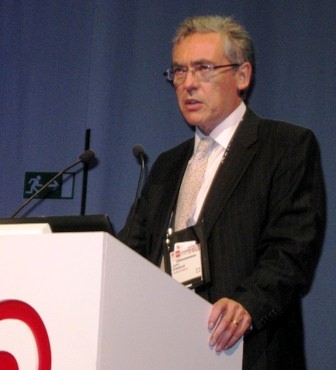MUNICH – Results from the largest study to ever assess treatment with spironolactone in patients with diastolic heart failure showed clear indications that the drug exerted beneficial structural, hemodynamic, and physiologic effects with a generally reasonable safety profile.
But the mottled results also showed a puzzling lack of efficacy for other end points, and when coupled with some worrisome signs of harm, most physicians will probably reserve judgment on using spironolactone on patients with heart failure and preserved left ventricular ejection fraction until results from an even larger, clinical end point trial are available next year.
Based on the results, "spironolactone can be considered in patients with diastolic heart failure for improving cardiac function and blood pressure control," Dr. Burkert M. Pieske said at the annual congress of the European Society of Cardiology.
Moreover, spironolactone’s performance in the Aldosterone Receptor Blockade in Diastolic Heart Failure (Aldo-DHF) trial with 422 patients randomized to treatment with spironolactone or placebo gives the drug a unique position in the world of diastolic heart failure: Spironolactone is now the only drug with any sort of positive track record in a prospective controlled trial.
"I can’t give a general recommendation to use it because patients [on spironolactone in the trial] did not feel better" after a year on treatment, Dr. Pieske acknowledged in an interview. "But if I had a [diastolic heart failure] patient on dual or triple antihypertensive therapy who still had high blood pressure, I would not hesitate to put the patient on spironolactone if their renal function and potassium level allowed it. This treatment will reduce blood pressure and improve cardiac structure and function," said Dr. Pieske, professor and head of the department of cardiology at the Medical University of Graz, Austria.
But other experts who heard the results had doubts.
"It was not all good news. Patients had an increase in their potassium level, and even more concerning, they had a reduction in their glomerular filtration rate, an average reduction of about 5 mL/min," commented Dr. Stefan D. Anker, professor of medicine at Charité Medical University in Berlin. In addition, the distance walked on the 6-minute walk test was "slightly decreased with spironolactone. Even though it was a small change of 15 m, it was statistically significant," he noted. On top of all this, "worsening of anemia was seen in patients," he added.
Dr. Anker advised waiting for results that are expected to come out next year from TOPCAT, a U.S. study of spironolactone in more than 3,500 patients with diastolic heart failure sponsored by the National Heart, Lung, and Blood Institute.
Aldo-CHF enrolled patients aged 50 years or older with New York Heart Association class II or III heart failure and a left ventricular ejection fraction of at least 50%. Patients also needed to have echocardiographic evidence of diastolic dysfunction, and a peak oxygen consumption (VO2) of less than 25 mL/kg per minute. The study excluded patients with a serum potassium level of 5.1 mmol/L or higher, and those with an estimated glomerular filtration rate of less than 30 mL/min per 1.73 m2 or a serum creatinine greater than 1.8 mg/dL. The patients averaged 67 years old, about 86% had class II heart failure, their average ejection fraction was about 67%, and their average GFR was about 79 mL/min per 1.73 m2.
The researchers randomized 213 patients to received 25 mg of spironolactone daily, and 209 control patients to placebo. Patients also received other medications, with about three-quarters on an angiotensin-converting enzyme inhibitor or angiotensin-receptor blocker, about three-quarters receiving a beta-blocker, and slightly more than half receiving a diuretic.
The study had two primary end points. After 12 months, patients on spironolactone had an average reduction in the E/é ratio of 0.6 (a 5% drop from baseline), compared with an average rise among the control patients of 0.8 (a 6% rise from baseline) for this surrogate measure of filling pressure, a significant between-group difference. The second primary end point was change in peak VO2, and for this measure the two groups showed very similar changes over the 12 months of the study without a significant between-group difference.
Patients on spironolactone also had a significant reduction in average blood pressure of 8/2 mm Hg at 12 months compared with baseline, but the beneficial effect that spironolactone had on myocardial reverse remodeling reflected in the change in E/é occurred independent of the drug’s blood pressure effect, Dr. Pieske said.
Secondary end points that showed beneficial effects from spironolactone treatment included a small but significant increase in left ventricular ejection fraction, and a significant reduction in serum levels of N-terminal prohormone brain natriuretic peptide (NT-proBNP), a marker of heart failure severity. But patients on spironolactone also had an average 15-m reduction in their 6-minute walk distance, a significant drop.



